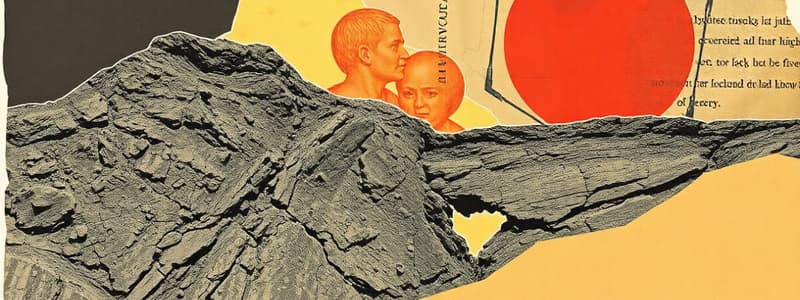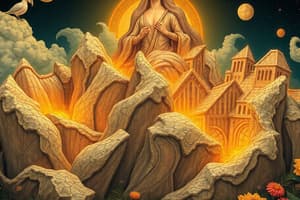Podcast
Questions and Answers
When does metamorphism occur?
When does metamorphism occur?
- If the rock's mineral composition is allowed to cool to form new type of rocks.
- If the rock's mineral composition transformed due to intense heat and pressure (correct)
- If the rock's mineral composition is removed due to intense heat and pressure
- If the rock's mineral composition is heated and melted due to intense pressure.
What is the primary agent responsible for metamorphism?
What is the primary agent responsible for metamorphism?
- Gravity
- Wind
- Water
- Heat and pressure (correct)
Which of the following factors can contribute to the intensity of metamorphism?
Which of the following factors can contribute to the intensity of metamorphism?
- Depth of burial
- Chemical reactions
- Duration of metamorphic conditions
- All of the above (correct)
In which tectonic setting does regional metamorphism primarily occur?
In which tectonic setting does regional metamorphism primarily occur?
Which of the following plate boundaries produces strong and devastating earthquakes?
Which of the following plate boundaries produces strong and devastating earthquakes?
What is the phenomenon of eruption of molten rock (magma) onto the surface of the Earth or a solid-surface planet called?
What is the phenomenon of eruption of molten rock (magma) onto the surface of the Earth or a solid-surface planet called?
What is a vent or opening on a planet's surface which allows molten rock called magma, volcanic ash and gas to escape out onto its surface called?
What is a vent or opening on a planet's surface which allows molten rock called magma, volcanic ash and gas to escape out onto its surface called?
What is the depression at the summit of a volcano, or at which is produced by a meteorite impact called?
What is the depression at the summit of a volcano, or at which is produced by a meteorite impact called?
What is a large depression typically caused by collapse or ejection of the summit area of a volcano called?
What is a large depression typically caused by collapse or ejection of the summit area of a volcano called?
What is the name of the type of volcano that often form the largest and tallest volcanoes? They are also the most explosive and dangerous of the types of volcanoes.
What is the name of the type of volcano that often form the largest and tallest volcanoes? They are also the most explosive and dangerous of the types of volcanoes.
What is the name of the type of volcano that are usually smaller in size than composite volcanoes, and the eruptions are smaller also. They form into steep cone shaped hills?
What is the name of the type of volcano that are usually smaller in size than composite volcanoes, and the eruptions are smaller also. They form into steep cone shaped hills?
What is the name of the type of volcano that is the widest type of volcano with a gentle slope due to the low viscosity or runny lava that it produces?
What is the name of the type of volcano that is the widest type of volcano with a gentle slope due to the low viscosity or runny lava that it produces?
What is the name of the type of lava flow that is smooth and continuous lava crust. It forms when the effusion rate is low and consequently the velocity of lava flow is slow. Usually flows at least 10 times slower than typical lava flow?
What is the name of the type of lava flow that is smooth and continuous lava crust. It forms when the effusion rate is low and consequently the velocity of lava flow is slow. Usually flows at least 10 times slower than typical lava flow?
What is the name of the type of lava flow that is a rough rubbly (resemblance of rubble) crust of a lava flow?
What is the name of the type of lava flow that is a rough rubbly (resemblance of rubble) crust of a lava flow?
What is the name of the type of lava flow that forms when hot lava flow into water and cools rapidly, creating long tubes and bulbous pillow-shaped mounds of rock?
What is the name of the type of lava flow that forms when hot lava flow into water and cools rapidly, creating long tubes and bulbous pillow-shaped mounds of rock?
What is the name of the type of lava flow that consist of large angular blocks of lava that are common if the silica content of lavas is higher (composition of basaltic, andesitic, to rhyolitic)?
What is the name of the type of lava flow that consist of large angular blocks of lava that are common if the silica content of lavas is higher (composition of basaltic, andesitic, to rhyolitic)?
Which type of volcanic eruption is the least violent?
Which type of volcanic eruption is the least violent?
Which type of volcanic eruption is characterized by short bursts of glowing lava created from the bursting of large gas bubbles?
Which type of volcanic eruption is characterized by short bursts of glowing lava created from the bursting of large gas bubbles?
Which type of volcanic eruption is relatively small but violent explosions of viscous lava create columns of ash and gas and occasional pyroclastic flows?
Which type of volcanic eruption is relatively small but violent explosions of viscous lava create columns of ash and gas and occasional pyroclastic flows?
Which type of volcanic eruption is the largest and most violent of all explosive eruptions, sending columns of pulverized rock, ash, and gases into the atmosphere?
Which type of volcanic eruption is the largest and most violent of all explosive eruptions, sending columns of pulverized rock, ash, and gases into the atmosphere?
What is the process of the formation of igneous rocks from the cooling and solidification of magma or lava?
What is the process of the formation of igneous rocks from the cooling and solidification of magma or lava?
Flashcards
Metamorphism
Metamorphism
The transformation of rocks due to temperature, pressure, and chemical conditions.
Agents of Metamorphism
Agents of Metamorphism
The factors causing metamorphism include temperature, pressure, and water.
Regional Metamorphism
Regional Metamorphism
Metamorphism associated with large-scale mountain-building processes.
Contact Metamorphism
Contact Metamorphism
Signup and view all the flashcards
Compression
Compression
Signup and view all the flashcards
Tension
Tension
Signup and view all the flashcards
Shearing
Shearing
Signup and view all the flashcards
Confining
Confining
Signup and view all the flashcards
Metamorphism Conditions
Metamorphism Conditions
Signup and view all the flashcards
Volcanism
Volcanism
Signup and view all the flashcards
Volcano
Volcano
Signup and view all the flashcards
Crater
Crater
Signup and view all the flashcards
Caldera
Caldera
Signup and view all the flashcards
Composite Volcano
Composite Volcano
Signup and view all the flashcards
Cinder Cone Volcano
Cinder Cone Volcano
Signup and view all the flashcards
Shield Volcano
Shield Volcano
Signup and view all the flashcards
Volcanic Gases
Volcanic Gases
Signup and view all the flashcards
Types of Eruption
Types of Eruption
Signup and view all the flashcards
Hawaiian Eruption
Hawaiian Eruption
Signup and view all the flashcards
Strombolian Eruption
Strombolian Eruption
Signup and view all the flashcards
Vulcanian Eruption
Vulcanian Eruption
Signup and view all the flashcards
Plinian Eruption
Plinian Eruption
Signup and view all the flashcards
Pahoehoe Lava
Pahoehoe Lava
Signup and view all the flashcards
Aa Lava
Aa Lava
Signup and view all the flashcards
Pillow Lava
Pillow Lava
Signup and view all the flashcards
Blocky Lava
Blocky Lava
Signup and view all the flashcards
Study Notes
Prayer
- A prayer used for guidance and learning
- Requests for guidance throughout the day
- Asking for the ability to see the world through God's eyes, listen with God's ears, and speak with God's mouth
- Seeking the heart to love and be kind to others
- Asking for God's protection over teachers, friends, and families
Earth Science Class - Quarter 4
- Shows a welcoming graphic for Earth Science class
- Quarter 4 is implied
Metamorphism
- Transformation of rocks and minerals due to changing temperature, pressure, and chemical conditions
- Agents/factors affecting metamorphism include: temperature, pressure, and water
Types of Metamorphism
- Regional Metamorphism: Associated with large-scale mountain-building processes
- Contact Metamorphism: Changes in rock caused by heat from a nearby magma body
- Burial Metamorphism: Layers in sedimentary basins; sediments increase in pressure and temperature without deformation. Zeolite is an example
- Hydrothermal Metamorphism: Change in chemical composition due to reaction with hot water; hot water accumulates dissolved metals and reacts with other rocks. Pegmatites and soapstones are examples
- Dynamic Metamorphism: Cataclastic metamorphism; rocks along fault lines scrape together, altering the rocks due to high pressure and low temperature. Mylonites are an example
Factors Influencing Rocks' Behaviour
- Compression: Rocks push or squeeze against each other, stress directed to the center
- Tension: Rocks pulled apart in opposite directions
- Shearing: Some portion of a plate at the edge may break away in different directions, making the plate smaller inside
- Confining: The crust becomes compact, leading to a smaller appearance
Oral Quiz
- When does metamorphism occur?: If the rock's mineral composition is transformed due to intense heat and pressure (option D is the correct answer)
- What is the primary agent responsible for metamorphism?: Heat and pressure (option C is the correct answer)
- Which of the following factors can contribute to the intensity of metamorphism?: Depth of burial, chemical reactions, and duration of metamorphic conditions (option D, all of the above is the correct answer)
- In which tectonic setting does regional metamorphism primarily occur?: Convergent boundaries (option B is the correct answer)
- Which of the following plate boundaries produces strong and devastating earthquakes?: Transform boundaries (option D is the correct answer)
Volcanism and Plutonism
- The objective includes describing and differentiating volcanic and plutonic rocks, and the process of volcanism and plutonism.
Volcanism
- The eruption of molten rock (magma) onto the surface of the Earth or a solid-surface planet
- Volcano: A vent or opening where molten rock, volcanic ash, and gases escape out onto the surface
- Plate movements usually form volcanoes along plate boundaries
Types of Volcanoes
- Composite Volcanoes: Form the tallest and largest volcanoes; highly explosive and dangerous
- Cinder Cone Volcanoes: Usually smaller and have smaller eruptions; form steep cone-shaped hills
- Shield Volcanoes: Widest volcanoes with gentle slopes due to low viscosity, or runny, lava
Volcanic Materials: Gas and Pyroclastic Materials
- Gases released during eruptions (water vapor, carbon dioxide, sulfur dioxide, hydrogen sulfide, and hydrochloric acid).
- Surface water into a volcanic system can greatly increase explosiveness.
Types of Volcanic Eruptions
- Hawaiian Eruptions: Fluid lava ejected; fire fountains or lava flows are seen
- Strombolian Eruptions: Short bursts of glowing lava from bursting gas bubbles at volcano vents
- Vulcanian Eruptions: Relatively small but violent explosions of viscous lava; columns of ash and gas, occasional pyroclastic flows
- Plinian Eruptions: Largest and most violent explosive eruptions; send columns of pulverized rock, ash, and gases miles into the atmosphere
Types of Lava Flows:
- Pahoehoe: Smooth and continuous lava crust; forms when effusion rate is low
- Aa: Rough and rubbly lava crust; common when silica content is high
- Pillow Lava: Forms when hot lava flows into water; creates tubes and bulbous rock shapes. Often under volcanoes that reach the surface.
- Blocky: Consists of large angular blocks of lava; often common if the lava has a higher silica content (basaltic, andesitic, or rhyolitic)
Closing Prayer
- A prayer of thanks to God for gifts and graces
- Affirming God as living and reigning
Studying That Suits You
Use AI to generate personalized quizzes and flashcards to suit your learning preferences.




